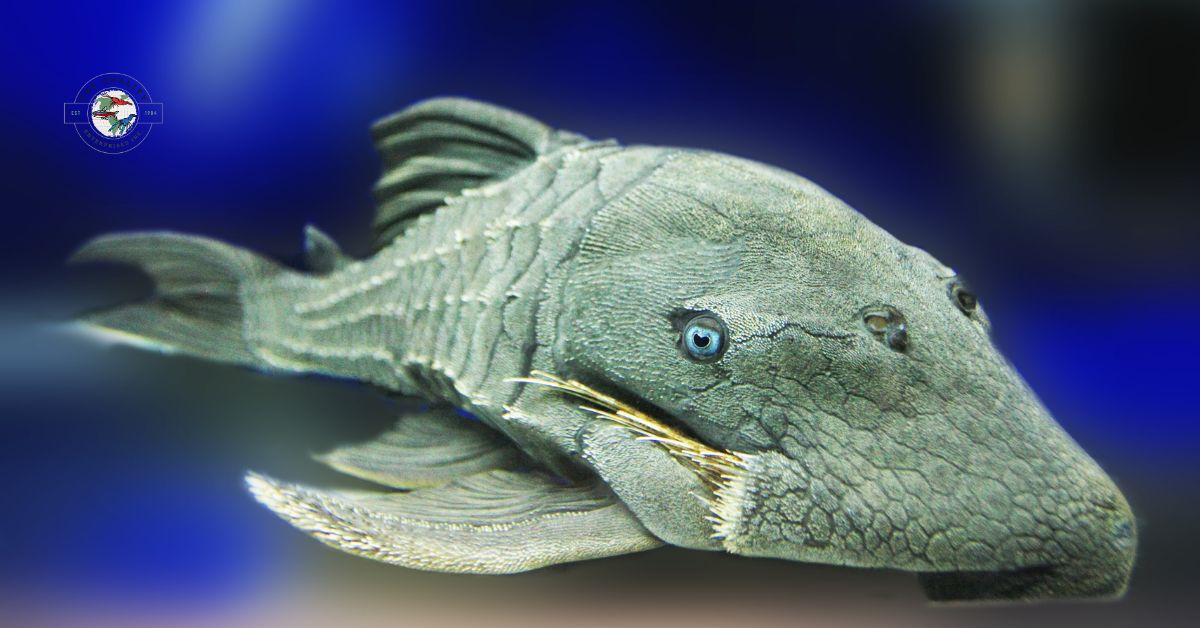One of the most stunning fish that belongs to the Loricariidae family is Blue-eyed Pleco. This pleco is a top favorite of most aquarists and fish keepers. It is a great addition to anyone’s aquarium, yet surprisingly, these plecos are rare. So, if you are looking for this and are lucky enough to find one, this blog will help you start your journey to keeping them.
This blog post will serve as your guide to everything you need to know about the beautiful Blue-Eyed plecos. Read further to discover amazing facts about them.
What are Blue-Eyed Plecos?
Long considered holy grail fish in the aquarium, these blue-eyed plecos remain the top picks among fish keepers. Like many other species, it is commonly found in fast-moving waters, particularly in Rio Magdalena in Colombia. Political instability has made accessing these plecos very difficult. Some can still be found and purchased by aquarists and hobbyists, yet their prices are extremely high.
Specie Summary
- Scientific Name: Panaque Cochliodon
- L-number: Not available
- Origin: Wild Colombia
- Adult size:24 inches
- Diet: Driftwood, biofilm, algae, and gel feeds
- Recommended Tank Size: 180 gallons
- Temperament: peaceful and friendly but can be aggressive toward conspecifics
- Lifespan: around 10 years
Husbandry Information
- Feeding: Blue-eyed plecos are omnivores and must always be fed a variety of diet of gel feeds, along with biofilm from driftwood. They must not be fed with large amounts of meaty foods high in protein. You can feed them with these on an occasional basis. It is best to feed these plecos before turning off the lights because they are nocturnal.
- Suggested Tankmates: Like many other pleco fishes, Blue-eyed-plecos stay at the lowest sections of their tanks and will never bother other fish. But they can be territorial and usually have problems with other bottom-dwelling species like catfish. Betta, Goldfish, Bristlenose pleco, angelfish, corydoras, and cichlids are some of the best tank mates of this pleco.
Behavior and Temperament
These plecos are interesting aquarium species that are mostly calm and will never cause any trouble in the tank. They will often scavenge for food without bothering other bottom-dweller fish. You will rarely see them in daylight because they are mostly active at night.
When you keep many plecos in your tank, expect to witness aggressive behavior from your blue eyes. Female blue-eyed fish, in particular, are not even territorial and aggressive compared to their male counterparts.
If your blue-eyed plecos are males and you keep other types in the tank together with them, territorial traits are about to be demonstrated. So, what can you do? Make sure to have a lot of hiding spots for them, for this prevents aggressiveness from happening. Caves are ideal hiding spots for your plecos.
Ideal Water Parameters
A Blue-eyed fish will need warmer water temperatures. In the wild, they often live in dark, warm, and full of driftwood streams and rivers with many food sources. In the aquarium, they need a more balanced and steady water parameter. Here are the specifics of the water parameters that you should take note of:
- pH: 6.4 -7.4
- Temp:75-80 Degrees Fahrenheit
- Ammonia:0ppm
- Nitrite:0ppm
- Nitrate:<30ppm
Additional Tip: When you first bring these plecos to your home, performing regular water tests is a must to ensure water parameters are favorable for your plecos. If you do not see any fluctuations inside the tank, there is no need to perform several tests as in the first week. In addition, we highly suggest getting a TDS or Total Dissolved Solids meter and changing the water every time your tank’s TDS crosses the normal and recommended range.
Tank Set-Up
Setting up the right water environment for these plecos is crucial. They are known to be easily distressed and often shy, making them susceptible to diseases and vulnerable to death. While they are not really fussy, you need to provide them with a few items inside their tank.
- Caves are a necessary item to place inside your tank. These caves serve as their hiding spots, especially during the daytime. Several pre-made caves available in the market today are specifically designed for plecos.
- Along with the caves, you have to put some rocks and driftwood, too, to create even more hiding spots and shades. These hiding spots and caves will block the light and provide a great place for the plecos to relax.
- The plecos have a soft belly, which means they need a softer and finer substrate. In their natural habitat, they were surrounded by muddy and sandy substrate. Therefore, it is essential that you recreate the same setting in your tank.
- Make sure to add some hardy plants to your tank to achieve a balance. You can opt for floating plants and any other aquarium plants to add beauty, aesthetics, and functionality to your tank.
Pleco Tank Size and Specifications
The minimum tank size for one Blue-Eyed pleco is sixty gallons. But if you want to keep other fish together with your Blue-eyed Pleco, ideally, you must get a 120-gallon tank and more. As usual, going for something much bigger than its actual size is always recommended. A large tank is proven to create a more stable and healthy environment for your fish.
- Filter System: Blue-eyed plecos need strong filtration, and we highly suggest the most powerful and high-quality filter you can get. Bigger and more powerful filters are the best option, for they can handle ammonia spikes better than small ones and keep your tank water crystal clear.
- Lighting: When it comes to lighting, choose the lights based on the type of plants you keep in your aquarium. Avoid using intense lighting, especially if you do not have any live plants, because these plecos prefer to always be in the shade. But if you have live plants and just want to use a stronger light for display reasons, add more hiding spots and caves so your Blue-eyed plecos will feel safe.
Breeding Blue-eyed Fish
First, you must know that these plecos are wild-caught and must still bred in captivity. You must recreate a similar environment to breed successfully, and re-creating it can be difficult. That is why these plecos have not yet been bred in captivity.
If you want to try it for yourself and do the breeding on your own, here are some professional tips we want to share with you:
- You will need your Blue-eyed plecos to reach maturity. The fish has to be 3 to 5 years old.
- Make sure to have a pair—one male and one female—to breed so you can start conditioning the fish for the breeding ritual.
- These plecos are wood eaters, breeding inside the caves made from fallen driftwood and logs. Thus, you must make a cave of the right size out of wood. This is to make the male trap the female inside.
- Change your fish diet to one that includes much higher-protein frozen foods. Foods with high protein encourage the female pleco to develop eggs. When the female develops eggs, it becomes fuller and rounder. This is the perfect time for the male to fan the cave and wait for its female counterpart.
Most Common Diseases and Prevention
There are no common diseases and illnesses specific to Blue Eyed Pleco. But like any other aquarium fish, they tend to get sick easily when tank parameters are unstable. Also, they can be vulnerable to the most known diseases that a new fish may carry to your tank. If you are to add a new fish, make sure to quarantine it properly. Doing so helps reduce the risk of spreading the diseases inside your tank.
Finally, prevention is the best cure! So, remind yourself to clean your tank regularly, check your water parameters every chance you get, do consistent water changes, and provide your plecos with high-quality snacks and foods.
Lifespan
In captivity, the lifespan of these plecos is estimated to be around 10 to 12 years. This is only possible if you remain consistent in giving them proper food and care. Another tip to ensure your pleco reaches its estimated age is to maintain your aquarium tank in pristine condition every single time. On top of that, you have to be keen on any diseases and prevent them from making their way to your tank.
Now You Have Learned So Much
As you finish this guide, we hope you have a better idea of Blue-eyed plecos and what it feels like to care for them. These stunning and beautiful species are not only a great addition to your pleco fish collection but also very rewarding to care for. They are independent and want nothing more than to mind their business and live peacefully in the bottom areas.
If you are considering collecting these plecos and have further questions, get in touch with us. We have a soft spot for Blue-eyed Pleco and would love to talk more about them with you.

